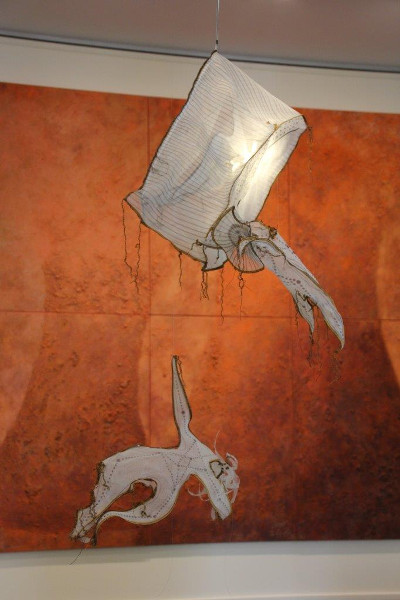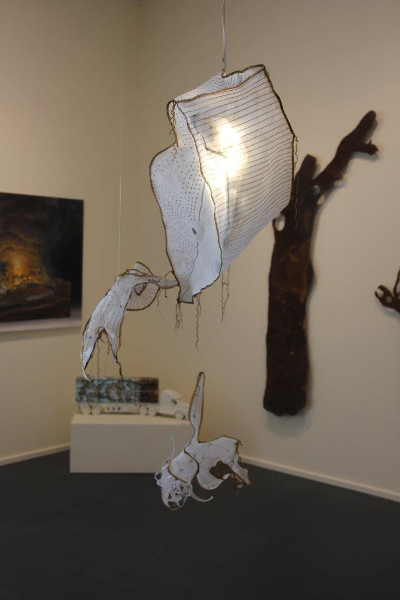Living Data
Algae/Mimi/Anthropocene
Living Data contributes an installation to An Anthropocene Cabinet of Curiosities
Australian Galleries, Melbourne 3 May - 24 May 2015 for the 2015 Climarte Festival
National Museum of Australia Review

William L. Fox, Director,
Centre for Art + Environment,
Nevada Museum of Art,
opens the exhibition,
The Warming and Anthropocene
Cabinet of Curiosities,
Australian Galleries, Melbourne.
Sunday 3 May 2015
Photo: Josef Goding


Lisa Roberts with Marc Pascal:
Algae, Mimi, Anthropocene:
Homo phagus meets Diatom navicula
(a love story for plant lovers)
Recycled Biomesh, hand-drawn,
machine-stitched.
Photos: Josef Goding
Notes in progress


Left: Navicula with Phagus
Objects: Lisa Roberts
Recycled Biomesh, hand-drawn,
machine-stitched.
Right: Anthropocene
Object: Lisa Roberts
Algae, Mimi, Anthropocene is an installation that came together quickly and surprisingly. Almost overnight, years of conversation, thought and dreaming, combined to find their place in the Anthropocene Cabinet of Curiosities, within a global conversation of iconography about our changing nature.
(Expand and link to words by scientists and artists in conversation about this iconography.)
I draw and stitch mesh to make iconic primal forms of microscopic algae and humans. I hang the algal forms from the ceiling in the Waterways exhibition (Central Park, Sydney), to draw attention to these tiny plants of the ocean that produce every second molecule of oxygen we breathe. When I play around with battery-powered bike lights inside the forms, this inspires an idea in Waterways curator Andrew Tovey. He suggests we illuminate and hang one algal form inside a wall, and drill a peep-hole through the wall so people can see it glowing in the dark. The form of algae that I choose to illuminate is Diatom navicula (boat-shaped).
Andrew and I fill the diatom form with fairy lights to suggest photosynthesis - the process that algae use to turn sunlight into sugar energy. The fairy lights flash on and off in random patterns, as I imagine they respond to changing light conditions in the Ocean. I hear from oceanographer Charlotte Robinson about the changing light in water and how algal may respond to the changes.
Next morning I wake with the idea of tiny human forms inside the algae. As I make the human forms I find myself relating more deeply to the science. It's like I bring the science into the bigger picture I have within me, where no line exists between past and present, spirit and body. It's like sense and imagination must ingest the science to connect my heart and head. Is this some psychological equivalent of phagocytosis? This thinking-feeling process leads me to combine my dream with scientific understandings about our evolution.
Phagocytosis - the biological process whereby one microorganism devours another and a symbiotic (mutually beneficial/reciprocal) relationship forms between them; independent life forms evolve to become inter-dependent.
I imagine the origin of phagocytosis as the biological 'big bang' that starts the evolution of species diversity that is vital for sustaining healthy living systems (including us). The boat shaped diatom and the idea of phagocytosis, combine in my mind to envisage a ship-burial carrying genetic inheritance through the ages, right through to the age of the Anthropocene.
Anthopocene - "Recent global environmental changes suggest that Earth may have entered a new human-dominated geological epoch, the Anthropocene....The evidence suggests that of the various proposed dates two do appear to conform to the criteria to mark the beginning of the Anthropocene: 1610 and 1964. The formal establishment of an Anthropocene Epoch would mark a fundamental change in the relationship between humans and the Earth system." Defining the Anthropocene. Simon L. Lewis1, 2, Mark A. Maslin1, Nature 519, 171-180 (12 March 2015) doi:10.1038/nature14258
One figure that I make becomes the Phagus in the diatom. This figure symbolises the phagocytosis process. Another figure becomes the Anthropocene. Its cut-open head suggests the two brain hemispheres that popular culture promotes as locations for analytic and sensory ways of processing information (or left and right brain thinking). Drawing on the Right Side of the Brain. Betty Edwards 1979
Ship-burial - practice of sending off the dead in boats to the afterlife. "A ship burial or boat grave is a burial in which a ship or boat is used either as a container for the dead and the grave goods, or as a part of the grave goods itself. If the ship is very small, it is called a boat grave. This style of burial was used among the Germanic peoples, particularly by Viking Age Norsemen." WikipediaTue 9 May 2015
I imagine ancestors on my father's side in ship burials, and reflect on my love of ships.


Left: Ernst Haeckel,
Diatom navicula bullata,
"Kunstformen der Natur" (1904)
Detail of Image: Haeckel Diatomea
Right: Model of Sutton Hoo
ship-burial 1, England.
Placement of burial chamber
is marked white.
Coccolithophorids are another form of algae that I represent by drawing, cutting and stitching mesh. The circular liths, or plates, that surround these algae look like crowns. I attach one to the head of another human form and immediately recognise a Mimi.
Mimi - spirit beings of Arnhem Land, Australia, in Indigenous Australian Dreaming. "When Aboriginal people first came to northern Australia, the Mimi taught them how to hunt and cook kangaroos and other animals. They also did the first rock paintings and taught Aboriginal people how to paint." (WikipediaTue 9 May 205) I imagine the Mimi teaching me, my mother, and our Indigenous ancestors how to paint.


Left: Calcifiers
(models of Emiliania huxleyi)
in Waterways exhibition
Objects: Lisa Roberts
with Martina Doblin
Photo: Martina Doblin
Right: Mimi
Object: Lisa Roberts
Recycled Biomesh, hand-drawn,
machine-stitched.











